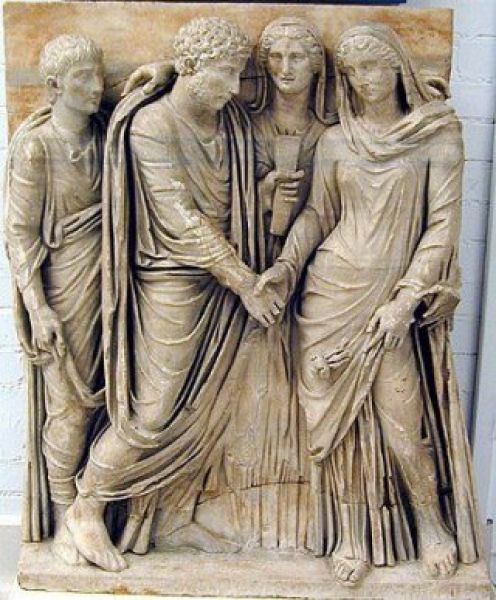Something (VERY) Old, Something New, Something Borrowed, Something Blue.
Ever thought about where our wedding traditions come from? You’ll be surprised how little has changed in 2000+ years.
The Business of Love
Marriage as an institution dates all the way back to around 1700 BC. By the time the Romans came onto the scene it was already a well established practice by which property, wealth, responsibility, and alliances were transferred across generations. That is, a practical means by which you may secure the future of your lineage in the most favourable way.
Marriage formed an essential part of the culture BUT in those days it was rarely seen as an institution of love. Like mergers and acquisitions in business today, the act of marriage in Roman times, was a pooling and trading of resources from one family to another in highly negotiated terms. These unions were typically orchestrated by the patriarch of each family, however, it is believed, although in no official terms, the maternal figure also held a large amount of influence in the negotiations.

In order for a marriage to be arranged and recognised both the groom-to-be and bride-to-be were required to have something called conubium – “the right to marry”. This meant that the participants had to answer the following questions: Are you old enough? (a very low bar to meet – usually around 12 years old for girls and 14 for boys), Are you a Roman citizen?, and Are you presently married to someone else? (Romans legal terms had no time for polygamy as it muddied the waters of inheritance). Once these parameters were met the most important question arises: SHOULD you marry this person? This was especially important in the upper classes, but up and down the line the search for the most advantageous match was crucial.
This idea of marriage as a business interaction has long endured even into the modern day; the concept of marriage for the sole purpose of love is somewhat of a recent development in history. We (many of us) dream of finding a partner, falling madly in love in some adorable way, having a big wedding with lots of cake, champagne and loads of friends, and then riding off into the sunset to live happily ever after in matrimony; and that is – at least according to the Hollywood Rom-Coms I’ve seen – the desired path through life. However, when we look at the union of Pompey the Great and his wife Julia (daughter of Julius Caesar), we see that they were actually ridiculed for their love and became the butt of jokes from their contemporaries. You married your wife for LOVE? How absurd!!
Love was considered a topic of contemplation for poets and philosophers but rarely had any practical place in a run-of-the-mill marriage.

Engagement Rings, White Dresses, Cake, and Other Familiar Things
Once a marriage had been arranged, the union could be publicly announced in a few different ways: the couple may appear in public holding hands, but often an engagement party would be organised by the father of the bride at their home with the groom-to-be sat as the guest of honour.
As a visible representation of her commitment to be wed, the bride would be given an engagement ring to wear on the ring finger of the left hand, as it was believed to be linked directly to the heart. Sound familiar?
Though a formal ceremony was not required to sanctify a marriage, it was as good a time as any to have a party. When picking out the day to hold such a reception there were many things to consider for the superstitious Romans. Strictly speaking the calends (first days of the month), nones (ninth day before the ides), and ides (middle day) of any month were to be avoided, as well as the entire months of February and May. June was considered to be the best month in which to wed as it was said to bring good fortune and a prosperous union. This may well be the origins of the “June Bride” expression.
“Oh they say when you marry in June, you’re a bride all your life, and the bridegroom who marries in June gets a sweet-heart for a wife”

On the day of the wedding the bride would be dressed by her mother in a single-piece, floor-length, white gown (familiar again?), with a ceremonial belt tied around her waist that only her new husband may remove, and a floral veil.
After a final confirmation of the terms of the marriage agreement, the parents of the bride would hand her over to the groom. During the ceremony the bride and groom would stand before a priest and exchange vows (I swear I’m not making this up), and finally offer a tribute to Jupiter; usually a pig or (something we are familiar with) a special cake. Following the signing of official paperwork and giving of gifts, the bridal party and guests would sit down to a meal and prepare themselves for the upcoming wedding procession. The procession was the key to all of the festivities, it symbolises the transfer of authority from the father of the bride to her new husband. She would be led out of her father’s house and lead the guests to her husband’s home. Winding through the streets the procession of people would grow larger and larger as the general public would join in for the fun of it.

When the bride arrived at the threshold of her husband’s home, the groom would pick up his bride and carry her through the doorway making sure that she would not trip, which would have been considered a bad omen from the Gods. Once inside the wedding guests would continue to feast and celebrate before the couple would be led to a decorated marital bed to consummate the marriage.
That’s how the Roman’s went about getting married. Though they may not have invented each and every practice, with what we know about Roman weddings, the similarities to the ceremonial traditions we have are undeniably uncanny. The big difference is that for better or worse, marriage has evolved into an institution of love rather than business.


Recent Comments